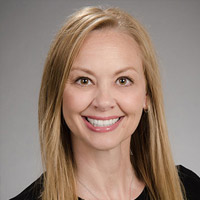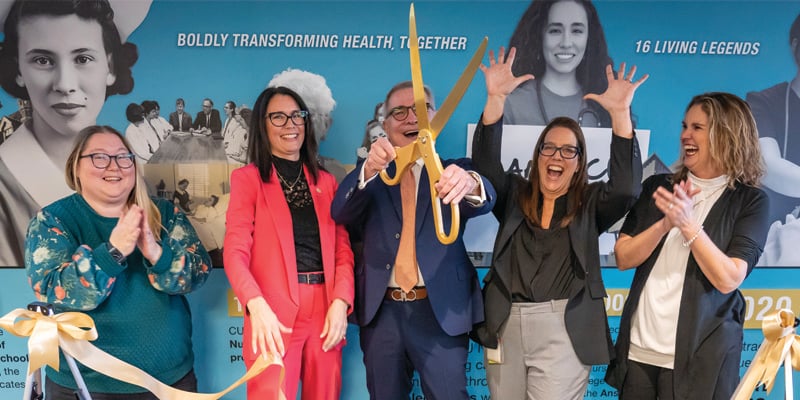After being in bedside nursing for a few years, you’d think you’ve seen just about every possible condition or patient scenario imaginable. Not true. Imagine trying to transition from a bedside nurse to a nurse practitioner/provider role. No longer are you taking orders and focusing on tasks. Now, you are the one analyzing the patient and developing the management plan.
“You’re having to think critically about why you’d tell a fellow nurse to do those tasks,” says Assistant Professor of Clinical Teaching Angela Pal, PhD, RN, ACNP-BC, CHSE, says. “Acute Care NP students realize the responsibility has shifted, and it’s very different.”
Transitioning to this new role is challenging.
Technology (more specifically simulation) is helping advanced practice nursing students at the University of Colorado College of Nursing at Anschutz Medical Campus become more comfortable taking charge, leading, and treating patients while using their nursing knowledge in a safe, non-clinical environment.
“Simulation helps graduate students prepare for that role transition to a nurse practitioner. Students – especially in the AG-ACNP program – have been bedside nurses or they’ve worked in the ICU. But now, they’re changing to a different role, and it’s a huge transition,” says Pal.
According to Pal, students studying to become nurse practitioners might get imposter syndrome. Or, they might feel uncomfortable changing roles to a provider, because in previous roles they were doing tasks instead of giving directions.
“I had simulation as a graduate nursing student at Duke University, and I felt that it really helped me build my confidence and ease that role transition for me,” she says.
Pal is partnering with Creighton University in Omaha, Nebraska to bring assessment of learners in simulation to advance practice nursing education. They are working together on a heart failure simulation scenario, expanding the Creighton Competency Evaluation Instrument (CCEI) to the next version, the CCEI 2.0.
Improving Simulation Education
Pal was asked by Creighton faculty to work on some of CCEI’s reliability testing for graduate students. She came up with the heart failure scenario used in the AG-ACNP class. Nurses in one of Pal’s AG-ACNP classes recently participated in a simulation on a patient with heart failure.
“Students came in and had to assess things like if the patient had a patent airway and if they’re breathing, or if the patient had a pulse,” she says.
“I think if we continue to grow our simulation programs,
we (CU Nursing) can be a leader in simulation education.”
Students query the patient to get their medical history. They get a better understanding of the patient and use critical thinking to develop differential diagnoses and the best treatment.
“With this patient, he had volume overload because he had high blood pressure, high cholesterol, and a previous heart attack,” Pal says. “The student can call a preceptor, their attending, or someone in cardiology for a consultation and develop a management plan.”
The scenario will be sent to about 200 NP faculty members across the US. Participating faculty will score the scenario using the CCEI 2.0 to determine the instrument’s reliability.
Reliability is testing to see if the results are consistent across the parts of the instrument over time, across different samples, and evaluators. Validity testing makes sure the instruments are measuring what it is designed to measure. The scores will be evaluated by a statistician with Creighton University for data analysis. Pal says a publication on the reliability testing will be published at some point in the near future, giving the instrument more credibility.
Evolving Simulation Techniques
Simulation in nursing has evolved since the COVID-19 pandemic.

Allie Kraybill, MS, AG-ACNP '23 consults with Assistant Professor Maggie Thompson during a sim lab experience. |
During the pandemic, CU Nursing students would virtually participate while a faculty member performed simulation scenarios in a lab. Students also used simulation software, called Oxford Medical Simulation (OMS), to engage in the care of patients virtually asynchronously.
“We found the software helpful because it helped them get indirect care hours they needed to graduate,” she says. “We now use the software in a pre-clinical course, right before they begin clinicals with real patients. They can debrief with faculty, and it helps them understand and apply the knowledge they’re learning.”
Now students use a variety of simulation technologies, including manikin-based, computer-based, and virtual reality. During a manikin-based simulation, the faculty performs a prebriefing that ensures the learners are oriented to the simulation event and situation (room and manikin). Learners then participate in a scenario as a provider. After the scenarios are completed, a faculty member leads a debriefing session, which helps learners reflect and apply learning content.
“We do our best to make it as realistic as possible,” she says. “We provide objectives and explain what we hope to accomplish during the simulation event. We give them a little information about the patient and then let them conduct the care of the patient in the scenario.”
During the scenario, faculty can also stop the simulation and take a “time out” if students get anxious or unable to move forward in the scenario. After all simulation scenarios, regardless of modality, the student and faculty member meet for a faculty-led debrief session.
“That’s where the learning takes place,” she says. “Faculty can ask a student about their thought process. It’s a confidential learning environment. Everything that happens in simulation stays in simulation.”




